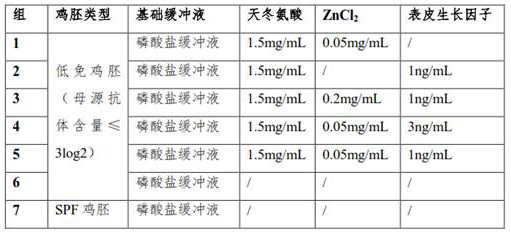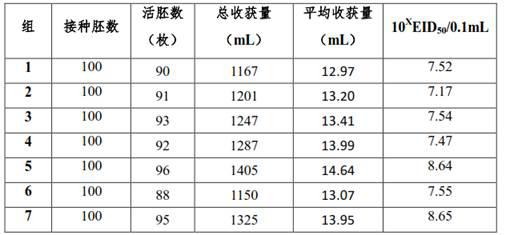Method for producing H7 subtype avian influenza virus inactivated vaccine by using low-immunity chick embryo
An avian influenza virus and inactivated vaccine technology, which is applied in the directions of microorganism-based methods, veterinary vaccines, biochemical equipment and methods, etc. Effect
- Summary
- Abstract
- Description
- Claims
- Application Information
AI Technical Summary
Problems solved by technology
Method used
Image
Examples
Embodiment 1
[0027] Embodiment 1: the impact of seed virus dilution on low immunity chicken embryo culture H7 subtype avian influenza virus
[0028] The company found in research and development that aspartic acid, ZnCl 2 and epidermal growth factor have a certain influence on the growth of chicken embryos and the proliferation of viruses in chicken embryos. In order to obtain the most suitable dilution of seed virus and improve the effect of virus proliferation in low-free chicken embryos, the company optimized aspartic acid acid, ZnCl 2 and the amount of addition of epidermal growth factor, through early research and development, it is found that the most suitable concentration of aspartic acid is 1.5 mg / mL, therefore, in the present invention, further ZnCl 2 and epidermal growth factor and its dosage have been further optimized test, the specific test design is as follows:
[0029] The culture method of H7 subtype avian influenza virus, after the H7 subtype avian influenza virus seed ...
Embodiment 2
[0039] Embodiment 2: Utilize the method for the production of H7 subtype avian influenza virus inactivated vaccine by low immunity chicken embryo
[0040] Step 1, get the H7 subtype avian influenza virus H7-Re2 strain virus seed and do 10 times serial dilution with the seed virus diluent, get 10 -4 For the diluted virus solution, inoculate 10-11-day-old low-immune chicken embryos in the allantoic cavity, 0.1ml per embryo, and continue to incubate at 37°C after inoculation, without turning the eggs;
[0041] Step 2: After inoculation of the chicken embryos, put eggs twice a day, discard the chicken embryos that died before 24 hours, take out the dead chicken embryos at any time after 24 hours, and take out all the live embryos at 72 hours, and the air chamber is upright , placed in a refrigerator at 2-8°C for 12 hours.
[0042] Step 3: Take out the chicken embryos that have been cooled for 12 hours, and after the surface is sterilized, push them into the harvesting operation r...
PUM
 Login to View More
Login to View More Abstract
Description
Claims
Application Information
 Login to View More
Login to View More - R&D
- Intellectual Property
- Life Sciences
- Materials
- Tech Scout
- Unparalleled Data Quality
- Higher Quality Content
- 60% Fewer Hallucinations
Browse by: Latest US Patents, China's latest patents, Technical Efficacy Thesaurus, Application Domain, Technology Topic, Popular Technical Reports.
© 2025 PatSnap. All rights reserved.Legal|Privacy policy|Modern Slavery Act Transparency Statement|Sitemap|About US| Contact US: help@patsnap.com



